
|

|

|
|
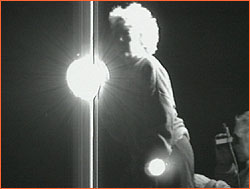 Lighting technician Cecilia Krigge spotlights for
leopard in the African night.
Lighting technician Cecilia Krigge spotlights for
leopard in the African night.
|
Behind the Scenes
by Peter Tyson
If you think filming leopards at night is difficult, you're
right. At the same time, you have no idea. Amanda Barrett and
Owen Newman, producers of
Leopards of the Night,
and their team spent more than 3,300 hours over the course of
three years shooting the film on location in Zambia and
Namibia. It was the hardest film either has ever made, they
say. Here's why:
The workday began around four o'clock in the afternoon. That's
when the film crew headed out into the bush in two cars. (One
held Barrett and Newman with the cameras, the other bore the
infrared lights and lighting technicians Vernon Bailie and
Cecilia Krigge.) The going was extremely rough. Foot- and
hoofprints that elephants and other large animals leave in the
wet mud of the rainy season dry out, forming concrete-hard
holes during the June to October dry season, when the team
filmed. "Leopards just glided over those holes, but it was
very bumpy for the cars," says Owen Newman, who was cameraman
as well.
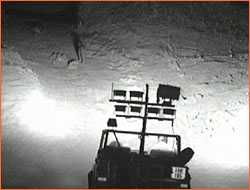 The film crew's lighting car sticks to the heels of a
roaming leopard.
The film crew's lighting car sticks to the heels of a
roaming leopard.
|
|
The first order of business was to find a leopard. That often
meant hours of searching for eyeshine with white spotlights
and listening for the alarm calls of impala and other prey.
Many nights passed when they never even laid eyes on a
leopard. When they did, they had to bring the cars close
without disturbing either the leopard or its prey. Once in
position, hours might pass before something filmable happened.
And it was cold: while the days were scorching, nights were
chilly enough to require scarves, hats, even mittens.
Typically the team stayed out all night, only turning back
about four in the morning. Sometimes it was longer. Once they
spent 56 hours straight in the car, waiting for a leopard to
return to a kill it had placed up a tree. "For all that
effort, sitting in the sun all day and no sleep, we used about
two shots," Barrett chuckles. In the end, they averaged one
good filming night every three weeks.
|
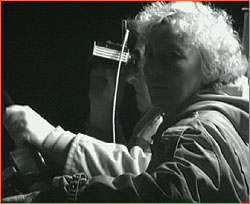 Night goggles offer lighting technician Vernon Bailie
a window into the night.
Night goggles offer lighting technician Vernon Bailie
a window into the night.
|
Filming at night also engendered many technical challenges.
The team brought along a Sony 7000 film camera for shooting in
low-light conditions, such as moonlight. But they had
discovered during an earlier film project that leopards
typically only hunt in pitch dark; if the moon is out, the
cats will wait for it to slip behind clouds before they make
their move. So, in a first in natural-history filmmaking in
Africa, Newman turned to infrared cameras. He used either a
Baxall or Cohu standard night security camera. Sensitive to
infrared light, which the team provided via special infrared
lights that Bailie aimed off the back of the lighting car,
these cameras can film in total darkness (see
The Camera That Caught a Leopard).
Since they were working with technology that no one had ever
used in that kind of situation before, they had to learn as
they went along, Barrett says. For one thing, neither infrared
camera had a viewfinder. So Newman, perched in the back of the
camera car, had to fly by the seat of his pants, as it were.
First, he took cues from Barrett, who sat up front wearing a
pair of night-vision goggles. While these devices, which
provide a grainy, bright-green view and are "a bit like
looking through very bad eyeglasses," Barrett says, they
allowed her to pick out leopards and other wildlife in the
darkness. She then described to Newman where to aim his
camera. "I would say something like, 'The leopard is at three
o'clock, about 25 meters away, crouched down by a patch of
grass,'" Barrett says.
 Focusing a long-focal-length lens on a moving leopard
was a daunting challenge.
Focusing a long-focal-length lens on a moving leopard
was a daunting challenge.
|
|
Newman then aimed his camera in that direction and watched a
nine-inch, black-and-white monitor to see what he was picking
up. But whenever he used a large lens, such as a 300 mm, the
depth of field was so shallow that he often missed his target
even when he was looking right at it. "I could be looking at
blades of grass, and the leopard could be six inches behind or
in front of that and I wouldn't see it on the monitor because
it was so out of focus," Newman recalls. "I would be swinging
the lens around and changing focus all the time. It was very
frustrating, especially when the leopards were stalking."
As if filming weren't challenging enough, Newman constantly
had to switch between the low-light and infrared cameras and
their respective lighting systems, depending on what the
leopard was up to. He did that in the pitch dark, up to 12
times in a night. "He got it down to seconds," Barrett says,
"but you'd only need one thing to go wrong, and you'd have
lost a filming opportunity that might have taken three weeks
to present itself." And things went wrong a lot, because
traveling over the uneven ground meant that cables and other
connections were regularly shaken loose.
|
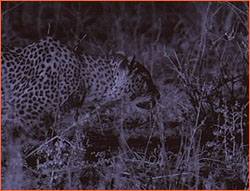 Even a pestering insect cannot disturb the exquisite
concentration of a stalking leopard.
Even a pestering insect cannot disturb the exquisite
concentration of a stalking leopard.
View
clip of leopard stalking:
RealVideo:
dialup
|
broadband
Quicktime:
757K
AVI:
757K
You'll need either the free
RealPlayer software, or free
QuickTime software
to be able to view this clip. If you already have
the software, choose the appropriate connection
speed/file size to view a clip.
|
Even when Newman had successfully zeroed in on a leopard, he
was at the mercy of the leopard's own unpredictable behavior.
"Compared to cheetahs and lions, leopards are very, very smart
hunters," Barrett says. "They'll try one way, then they'll
change their minds, double back, go all the way around the
target animal in a big detour, and try it from the other side.
We would have to move with the leopard, without upsetting
either the prey or the leopard." She laughs. "We'd get all the
way there, and then she'd change her mind again and try
another angle."
They also had to be on their guard against the leopards
themselves. While the cats largely ignored them, the film crew
could never forget that these were wild animals. "Once we were
just below a male leopard that had killed a baboon and was
eating it in a tree," Newman recalls. "He got a bone stuck in
his cheek and couldn't get it out. After that he became quite
aggressive, thrashing his tail from side to side and getting
angry with himself. We decided to back away from that."
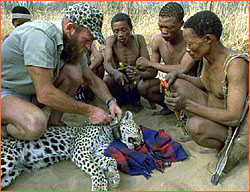 Leopard researcher Philip Stander and his Bushmen
colleagues adjust the radio collar of a tranquilized
leopard in Namibia.
Leopard researcher Philip Stander and his Bushmen
colleagues adjust the radio collar of a tranquilized
leopard in Namibia.
|
|
Leopards were not the only creatures to be wary of. Once,
while filming a pride of lions vying with crocodiles over an
antelope kill, the team lost track of the lions in the pitch
darkness. "We had five lions behind the car, about three in
front, and one by the side," Barrett remembers. "Then a couple
started mating. Bear in mind we were in a completely open
vehicle. We didn't know if one by accident might jump into the
car to get away from a crocodile or another lion. That made us
sit up and concentrate." Most dangerous of all, it turns out,
was the mosquito. During the filming, both Barrett and Newman
came down with cerebral malaria. In fact, the disease caused
Newman, who suffered two debilitating bouts, to sit out the
only night he missed in ten solid months of filming.
Despite the myriad difficulties associated with making the
film, there were substantial rewards. For Newman, it was the
chance to be out all night in the African bush, with myriad
insect and bird sounds and various plants coming into flower.
("As you moved through the park," he says, "you could
sometimes tell where you were just by the flower smell.")
Barrett particularly appreciated working with the Bushmen.
"They were so much in their element in the desert, whereas we
were staggering around hot, sweaty, clutching water bottles,"
she recalls. "We wouldn't have lasted a second if they had
left us."
|
 "His sleek fur reflected different shades of apricot
and chestnut in the sunlight."
"His sleek fur reflected different shades of apricot
and chestnut in the sunlight."
|
Most rewarding, of course, were the leopards. The team filmed
leopard behavior never before seen, including the supreme
concentration the cats hold while stalking prey in the pitch
dark, and the surprising fact that a leopard—usually the
most silent of stalkers—will sometimes deliberately
stamp the ground with its foot to disorient prey. For Barrett,
the most fulfilling moment of all came one afternoon when a
male leopard they'd been working with for three days and
nights sauntered over to sleep in the shade of the car. "He
had just killed and was full of food, and he was very relaxed
with us because we hadn't done anything to upset him," she
says. "We could hear him snoring. He was in the peak of
condition, with a thick, muscular neck and his sleek fur
reflecting different shades of apricot and chestnut in the
sunlight. Beautiful animal."
Peter Tyson is Online Producer of NOVA.
Night Vision
|
Camera that Caught a Leopard
Behind the Scenes
|
Seeing through Camouflage
Resources |
Transcript
| Site Map |
Leopards Home
Editor's Picks
|
Previous Sites
|
Join Us/E-mail
|
TV/Web Schedule
About NOVA |
Teachers |
Site Map |
Shop |
Jobs |
Search |
To print
PBS Online |
NOVA Online |
WGBH
©
| Updated November 2000
|
|
|



 Lighting technician Cecilia Krigge spotlights for
leopard in the African night.
Lighting technician Cecilia Krigge spotlights for
leopard in the African night.
 The film crew's lighting car sticks to the heels of a
roaming leopard.
The film crew's lighting car sticks to the heels of a
roaming leopard.
 Night goggles offer lighting technician Vernon Bailie
a window into the night.
Night goggles offer lighting technician Vernon Bailie
a window into the night.
 Focusing a long-focal-length lens on a moving leopard
was a daunting challenge.
Focusing a long-focal-length lens on a moving leopard
was a daunting challenge.
 Even a pestering insect cannot disturb the exquisite
concentration of a stalking leopard.
Even a pestering insect cannot disturb the exquisite
concentration of a stalking leopard.  Leopard researcher Philip Stander and his Bushmen
colleagues adjust the radio collar of a tranquilized
leopard in Namibia.
Leopard researcher Philip Stander and his Bushmen
colleagues adjust the radio collar of a tranquilized
leopard in Namibia.
 "His sleek fur reflected different shades of apricot
and chestnut in the sunlight."
"His sleek fur reflected different shades of apricot
and chestnut in the sunlight."